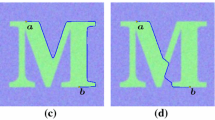Abstract
As a simple meaningful external illustration, a group of boundary contours is commonly used for representing the physical appearance of an object of interest on a 2D plane (e.g., a part drawing, CT scan image, a sliced layer, tile pattern). The illustration is understood from the composition of the contours and their attributes that include their shapes, sizes, locations and relationships. Therefore, not only is geometrical information important for contours to be useful in subsequent operations but their topological hierarchy relationships also are essential. Presented in this paper is a topological hierarchy-contour tracing algorithm that is capable of tracing nests of interconnected contours often found in practice and of identifying their topological hierarchy relationships automatically during contour tracing. The algorithm organizes contours by family rather than by group or as individual. However, contours are traced across families generation by generation instead of going deep with one family branch at a time. The outputs of the algorithm are ordered sequences of boundary pixels representing all closed contours and their topological hierarchy relationships. The algorithm has been implemented on LabVIEW, and tested with several samples to illustrate its applications.
Similar content being viewed by others
References
Flower J, Howse J, Taylor J (2003) Nesting in Euler diagrams. Electron Notes Theor Comput Sci 72:93–102
Gonzalez RC, Woods RE, Eddins SL (2004) Digital image processing using Mathlab. Pearson Prentice-Hall, New Jersey
Pratt WK (1991) Digital image processing. Wiley-Interscience, New York
Ghuneim AG (2009) Contour tracing. http://www.imageprocessingplace.com/ downloads_V3/root_downloads/tutorials/contour_tracing_Abeer_George_Ghuneim/alg.html. Accessed 01 Oct 2009
Mirante A, Weingarten N (1982) The radial sweep algorithm for constructing triangulated irregular networks. IEEE Comput Graph 2(3):11–21
Pavlidis T (1982) Algorithm for graphics and image processing. Computer Science, Rockville
Kass M, Witkin A, Terzopoulos D (1988) Snakes: active contour models. Int J Comput Vis 321–331
Iannizzotto G, Vita L (2000) Fast and accurate edge-based segmentation with no contour smoothing in 2-D real images. IEEE Trans Image Process 9:1232–1237
Strathy NW, Said F, Suen CY (1994) A sequential method of extracting contour chains from an image. Proceedings of the 12th IAPR International Conference on Pattern Recognition 2:580–582
Park SC, Choi BK (2001) Boundary extraction algorithm for cutting area detection. Comput Aided Des 33:571–579
Ablameyko S, Pridmore T (2000) Machine interpretation of line drawing images. Springer, London
Chen J, Qiao C, Zhao R (2004) A Voronoi interior adjacency-based approach for generating a contour tree. Comput Geosci 30:355–367
Choi SH, Kwok KT (2002) Hierarchical slice contours for layered-manufacturing. Comput Ind 48:219–239
Choi SH, Cheung HH (2009) A topological hierarchical-based approach to layered manufacturing of functionally graded multi-material objects. Comput Ind 60:349–363
Volpato N, Franzoni A, Luvizon DC, Schramm JM (2013) Identifying the directions of a set of 2D contours for additive manufacturing process planning. Int J Adv Manuf Technol 68(1–4):33–43
Fonseca MJ, Ferreira A, Jorge JA (2009) Sketch-based retrieval of complex drawings using hierarchical topology and geometry. Comput Aided Des 41:1067–1081
Kuagoolkijgarn P, Koomsap P, Chansri N (2010) A new algorithm for tracing nests of interconnected contours. Int J Adv Manuf Technol 50(5–8):717–727
Egenhofer MJ, Franzosa RD (1991) Point-set topological spatial relations. Int J Geogr Inf Syst 5(2):161–174
Guilbert E (2013) Multi-level representation of terrain features on a contour map. Geoinformatica 17:301–324
Ma W, Chu KY (2000) Extracting geometric features from a virtual environment. J Mater Process Technol 107:24–30
Cronin T (2000) Classifying hills and valleys in digitized terrain. Photogramm Eng Remote Sens 66(9):1129–1137
Choi SH, Samavedam S (2001) Visualisation of rapid prototyping. Rapid Prototyp J 7(2):99–114
Chen LJ, Liu TG, Chen JJ, Zhu JC, Deng JJ (2006) Location algorithm for seal imprints on Chinese bank-checks based on region growing. Optoelectron Lett 2(2):155–157
Roubal J, Poiker T (1985) Automated contour labeling and the contour tree. Proceedings of Auto-Carto 7:472–481
Kovalevsky VA (1989) Finite topology as applied to image analysis. Comput Vision Graph 46(2):141–161
Maire C, Datcu M (2005) Object and topology extraction from remote sensing images. Proceedings of IEEE International Conference on Image Processing: II-193-II-196
Kim DK, Lee DR, Pham TC, Nguyen TT, Jeon JW (2007) Real-time component labeling and boundary tracing system based on FPGA. Proceedings of the 2007 I.E. International Conference on Robotics and Biomimetics 189–194
Chang F, Chen CJ (2003) A component-labeling algorithm using contour tracing technique. Proceedings of the 7th International Conference on Document Analysis and Recognition
Chang F, Chen CJ, Lu CJ (2004) A linear-time component-labeling algorithm using contour tracing technique. Comput Vision Image Underst (CVIU) 93:206–220
Codrea MC, Nevalainen OS (2005) Note: an algorithm for contour-based region filling. Comput Graph 29:441–450
Sunanon P, Koomsap P, Nachaisit S (2005). Image processing for rapid prototyping technology. Proceedings of the 2005 International Conference on Simulation and modeling, pp 249–253
Author information
Authors and Affiliations
Corresponding author
Rights and permissions
About this article
Cite this article
Koomsap, P., Chansri, N. Topological hierarchy-contour tracing algorithm for nests of interconnected contours. Int J Adv Manuf Technol 70, 1247–1266 (2014). https://doi.org/10.1007/s00170-013-5330-1
Received:
Accepted:
Published:
Issue Date:
DOI: https://doi.org/10.1007/s00170-013-5330-1




